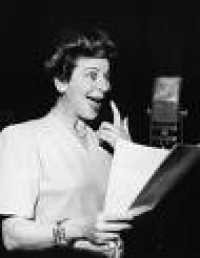Jerry Seinfeld is the latest in a long line of Jewish comic geniuses, such as Harold Lloyd, Eddie Cantor, George Burns, Milton Berle, Buddy Hackett, Sid Ceasar, Lennie Bruce, Mel Brooks and Gilda Radner, to name but a few.
Seinfeld presents a relatively new image of the American Jewish comedian: low-key and au courant. With the exception of Lloyd and Burns, the great majority of successful American Jewish comedians attained popularity by fulfilling widely accepted ethnic Jewish stereotypes or by employing a manic, burlesque style of humor. In the first half of the 20th century, these expectations were almost impossible for Jewish comics to escape. No career illustrates the limits and possibilities of being a Jewish comedian better than that of Fanny Brice.
Born on the Lower East Side of New York in 1891, the third of four children of immigrant saloon-owners, Fania Borach decided early in life to become a performer. Historian Barbara Grossman notes that in an era in which entertainment was typically based on ethnic stereotypes -the drunken Irishman, the ignorant Pole, the Yiddish-accented greenhorn - Brice's "Semitic looks" slotted her into Jewish roles. Despite her efforts to succeed as a serious actress and singer, Brice - who spoke no Yiddish - rose to stardom performing comedy with a Yiddish accent.
In 1908, dropping out of school after the eighth grade, the gangly, strong-voiced Fanny Borach found work as a chorus girl in a burlesque review. By the end of that year, she changed her name to Brice, probably, Grossman speculates, to escape limited Jewish stage roles. Ironically, a year later, she would make her first Broadway mark in a musical comedy, The College Girls, singing Irving Berlin's "Sadie Salome, Go Home" with a put-on Yiddish accent, while dancing a parody of the seductive veil dance in Richard Strauss' opera Salome. Her act brought down the house. Despite her desires, Brice had found her place as a "Jewish" entertainer.
Brice starred in the Ziegfield Follies in the 1920s and 1930s and became known for her beautiful voice and limber grace, which she always used in the service of humor. When she tried dramatic Broadway roles, her plays were unsuccessful.
As Brice's fame increased, so did her notoriety. In 1918, she married Jules "Nicky Arnstein, a handsome, urbane but somewhat inept con man and thief she had lived with for six years. Despite Arnstein's infidelity and a stretch in Sing Sing Prison for illegal wiretapping, the devoted Brice stayed with him, had two children and supported him by working on-stage almost constantly. Brice's tumultuous relationship with the ne'er-do-well Arnstein gave her material for a rare non-ethnic success: appearing in the Ziegfield Follies of 1921, the usually manic comedienne stood nearly motionless on the stage and, singing in a beautiful, unaccented voice, moved audiences to tears with her rendition of "My Man" with its now-classic lyrics, "But whatever my man is, I am his - forever."
In 1924, Arnstein was charged in a Wall Street bond theft. Brice insisted on his innocence and funded his legal defense, at great expense. Arnstein was convicted and sentenced to the Federal penitentiary at Leavenworth. Released in 1927, the ungrateful and unfaithful Arnstein disappeared from Brice's life and that of his two children. Reluctantly, Brice divorced him.
Brice had some of her greatest success during her years as Mrs. Arnstein, including her famous song "Second Hand Rose." Yet, in 1923, as biographer Grossman puts it, Brice "tired of being a sight gag" and had her nose surgically straightened. Still, acceptance eluded her when she tried her hand at "American" drama.
After a failed marriage to Broadway impresario Billy Rose and starring roles in Hollywood film, Brice found a niche -broadcast radio - that made her comfortable. In 1938, she launched her own weekly radio show. A wonderful mimic and impersonator with a great ear for dialect, Brice chose instead to limit herself to one character, Baby Snooks, a precocious, bratty toddler - who had no accent. Her enormously successful run on radio lasted until her death in 1951, just as television was beginning to capture the radio audience.
Barbra Streisand paid tribute to Brice in her loosely biographical film Funny Girl. Lily Tomlin popularized a Baby Snooks-like character on television, Edith Ann, who sits in a rocking chair and makes ironic observations on the adult world. Both stars possess a freedom to choose roles that women have earned since Brice was slotted as Sadie Salome. Just as significant, the acceptance of Jerry Seinfeld's comfortable Jewish identity by a national audience illustrates the great liberation that American Jewry, male or female, has gained in the world of entertainment.
Source: http://www.jewishvirtuallibrary.org/jsource/biography/brice.html
